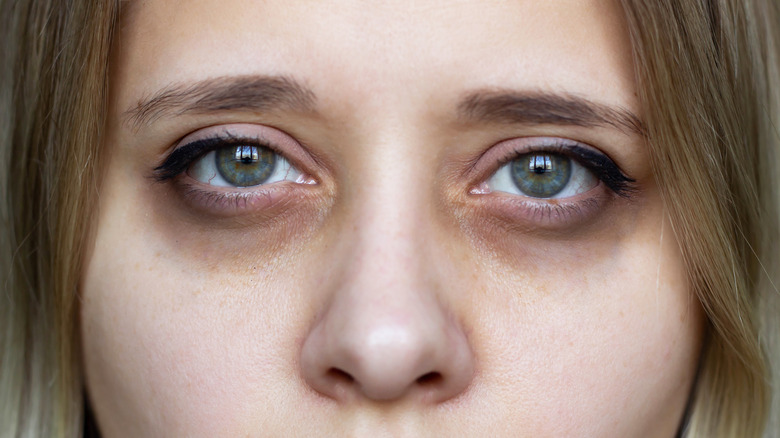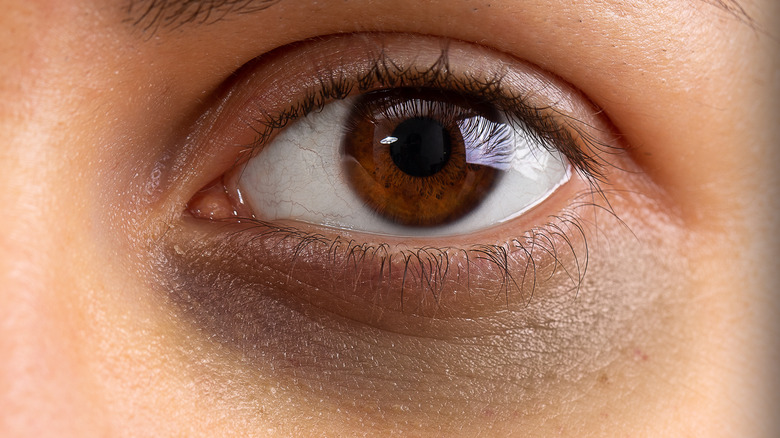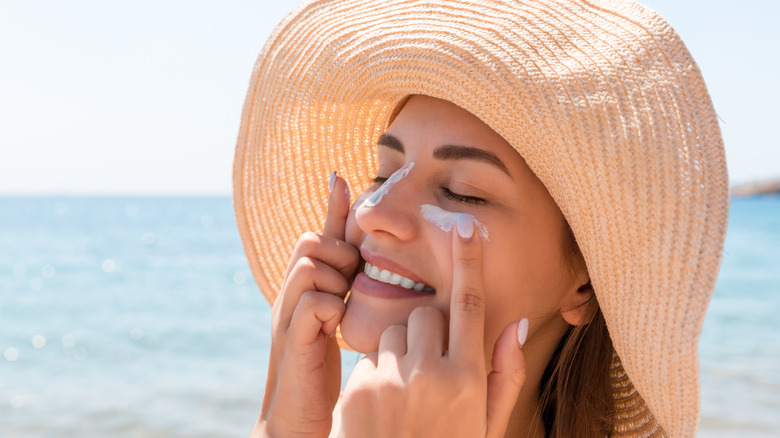What Are The Different Types Of Dark Circles?
If you're working virtually, then chances are you are spending a lot of time on Zoom meetings. But if you don't like getting on camera, it looks like you may not be the only one. Researchers are reporting a growing trend of "Zoom dysmorphia," or the negative self-perception from seeing your face on camera (per International Journal of Women's Dermatology). Dermatologists across the U.S. are reporting an increase in people seeking consultations for cosmetic reasons, with nearly 65 percent of those patients specifically expressing concerns about their dark circles.
So if you're one of those people who are wondering what causes dark circles, you are certainly not alone. Making lifestyle changes so that you are sleeping eight hours a day, drinking eight glasses of water a day, eating vitamin-rich food, and applying sunscreen can all help in preventing and reducing dark circles that may be appearing all of a sudden (via Healthline). However, lifestyle changes may not be enough to treat dark circles for everyone.
While lack of sleep and dehydration can be factors that worsen dark circles, dark circles can also be hereditary, per Dr. Christopher Zoumalan. Things like inborn allergies that cause the blood vessels under your eyes to expand or poor blood circulation that causes the vessels to build up are a few genetic reasons that could be the cause behind dark circles. To reduce the appearance of genetic dark circles, it's important to pinpoint the type of dark circles you have.
Which type of dark circles do you have?
According to the International Journal of Dermatology, there are four types of dark circles: pigmented, vascular, structural, and mixed type. Pigmented dark circles are brown, while vascular dark circles have a blue/pink/purple undertone and may or may not be puffy (via DocOnline). Pigmented dark circles are a result of excess melanin under the eye, while vascular dark circles are present in those with poor blood circulation and/or transparent skin under the eyes (per Get Healthy Skin). Those who have deeper set eyes, or experience a loss of fat in the undereye-area could experience structural dark circles from the appearance of shadows. Mixed-type dark circles are dark circles that are any combination of the three previous types.
To find out what type of dark circle you might have, a simple trick is to gently pinch your undereye skin and shift it around so you can see the undertone of the skin in that area (per Southern Living). If your undereyes have a bluish or brown undertone to them that moves with the skin, then you are likely suffering from pigmented dark circles. On the other hand, if your undereyes have a bluish tint that fades away as you pinch your skin, then that could mean that you're dealing with vascular dark circles.
How to treat dark circles
Before treating dark circles, it's important to try to pinpoint the root cause of it. Vascular dark circles can be caused by genetics, eye-rubbing, lack of sleep, or allergies. Pigmented dark circles, which are more common in people with darker skin tones, can be caused by genetics and/or sun damage. Structural dark circles can be caused by genetics or aging.
Ingredients that can boost collagen production like vitamin C and hyaluronic acid are recommended for those with vascular dark circles, per Southern Living. Vitamin C can also help lighten hyperpigmentation under the eyes for those with pigmented dark circles, per Get Healthy Skin. Dermatologist Cindy Yoon Soo Bae told Byrdie, "Lightening products with kojic acid, glycolic acid [and] hydroquinone can be helpful." Kojic acid comes from mushrooms and is known to lighten hyperpigmentation.
Peptides and caffeine can especially help those with vascular dark circles, per Get Healthy Skin. If you have structural dark circles, Dr. Christopher Zoumalan recommends consulting with your dermatologist on getting fillers under the eyes, to replace any lost fat that may be causing shadows. Get Healthy suggests peptides, retinol, and hyaluronic acid for those with structural dark circles. According to Elite Daily, the most important thing anyone can do is to use an eye cream with SPF in it to prevent your delicate undereye skin from darkening as a result of UV exposure.


